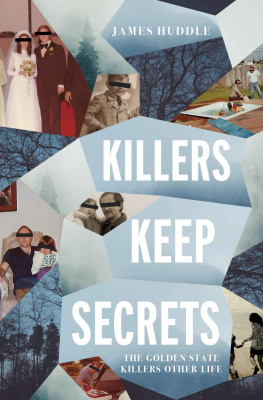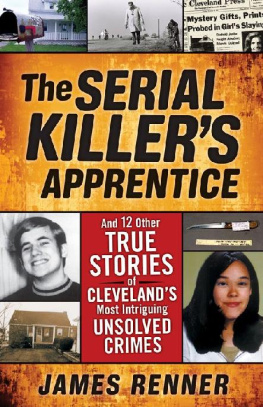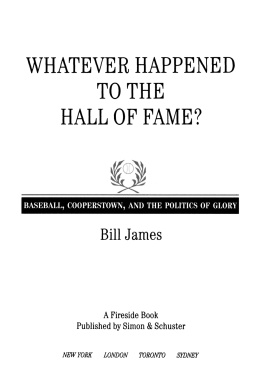Thank you for downloading this Simon & Schuster ebook.
Get a FREE ebook when you join our mailing list. Plus, get updates on new releases, deals, recommended reads, and more from Simon & Schuster. Click below to sign up and see terms and conditions.
CLICK HERE TO SIGN UP
Already a subscriber? Provide your email again so we can register this ebook and send you more of what you like to read. You will continue to receive exclusive offers in your inbox.
We hope you enjoyed reading this Simon & Schuster ebook.
Get a FREE ebook when you join our mailing list. Plus, get updates on new releases, deals, recommended reads, and more from Simon & Schuster. Click below to sign up and see terms and conditions.
CLICK HERE TO SIGN UP
Already a subscriber? Provide your email again so we can register this ebook and send you more of what you like to read. You will continue to receive exclusive offers in your inbox.
ALSO BY BILL JAMES
The Bill James Baseball Abstract
The Bill James Historical Baseball Abstract
This Time Lets Not Eat the Bones
The Bill James Baseball Book
Whatever Happened to the Hall of Fame?
The Bill James Player Ratings Book
The Bill James Guide to Baseball Managers
The New Bill James Historical Baseball Abstract
Win Shares
The Bill James Handbook
The Neyer/James Guide to Pitchers (with Rob Neyer)
The Bill James Gold Mine
Popular Crime

Scribner
An Imprint of Simon & Schuster, Inc.
1230 Avenue of the Americas
New York, NY 10020
www.SimonandSchuster.com
Copyright 2017 by Bill James
All rights reserved, including the right to reproduce this book or portions thereof in any form whatsoever. For information, address Scribner Subsidiary Rights Department, 1230 Avenue of the Americas, New York, NY 10020.
First Scribner hardcover edition September 2017
SCRIBNER and design are registered trademarks of The Gale Group, Inc., used under license by Simon & Schuster, Inc., the publisher of this work.
For information about special discounts for bulk purchases, please contact Simon & Schuster Special Sales at 1-866-506-1949 or .
The Simon & Schuster Speakers Bureau can bring authors to your live event. For more information or to book an event, contact the Simon & Schuster Speakers Bureau at 1-866-248-3049 or visit our website at www.simonspeakers.com.
Interior design by Kyle Kabel
Jacket design by Christopher Sergio
Jacket photograph Alan Black/Arcangel
Library of Congress Cataloging-in-Publication Data is available.
ISBN 978-1-4767-9625-3
ISBN 978-1-4767-9627-7 (ebook)
This book is dedicated to those who lost their lives to the violence chronicled in the following pages.
I t is a warm night, most often on a weekend. There is a very small town with a railroad track that runs through the town, or sometimes along the edge of it. You cant get more than a few hundred feet away from the railroad track and still be in the town. He is looking for a house with no dog. He would prefer a house on the edge of town, just isolated enough to provide a little bit of cover. A big two-story house would be best, with a family of five. A barn where he can hide out from sundown until the middle of the night, but in that era, before the automobiles came, almost every house had a barn; even the houses in Chicago and Philadelphia had barns. He is looking for a house with a woodpile in the front yard, and an axe sticking up out of the woodpile.
Preface
I have long been fascinated by the notion that knowledge can be created about the past. Dinosaurs are the easiest example. For tens of thousands of years, humans had no awareness that the world had once been inhabited by gigantic beasts. Now, we know not merely that these animals existed, but we have identified hundreds of species of them. We know what they looked like, generally, and what they ate. We know which type of dinosaur lived where, and in what era. We know what happened to them. We have not merely created this knowledge, we have disseminated it so widely across our culture that the average five-year-old now can name a dozen types of dinosaurs, and has a collection of little plastic models of them.
In my day job I am a baseball writer. We know many, many things now about the baseball players of the 1950s and 1960s, about Willie Mays and Bob Gibson and Stan Musial, that those men themselves did not know and could not possibly have known when they were playing. We have pieced together records of their careers that are far more complete than the records which were kept at the time. Modern historians know things about the Romans that the Romans themselves did not know and could not have known.
A hundred years ago and a little more, there were a series of terrible crimes that took place in the American Midwest (although it actually started in the Northeast and the South, the midwestern portion of the series is the well-known part). The most famous of these crimes are the murders in Villisca, Iowa, but it is apparent to anyone who will take the time to look that the Villisca murders were a part of a series of similar events. I was reading about that series of crimes and I had a thought. Ill bet there were others, I thought, that the contemporary authorities never linked to the same criminal.
With modern computers, we can search tens of thousands and hundreds of thousands of small-town newspapers, looking for reports of similar events.
And I found one.
And then I found another one, and another one, and another one. I hired my daughter as a researcher, and she started finding them. We had no idea what we were dealing with. And we never dreamed that we would actually be able to figure out who he was.
By the time he came to Villisca, The Man from the Train had been murdering randomly selected families for a decade and a half. People had been executed for his crimes; people had been lynched for his crimes; and people were rotting away in prison for his crimes.
Skeptical? Of course youre skeptical. Youre either skeptical or youre stupid, and you dont look stupid. But hear me out. Have I got a story to tell you.
Bill James
Villisca
T he Devil came to Villisca on June 9, 1912, and to this day, if you mention Villisca to anyone from Iowa, the first thing they will think about is the murders. It was a Sunday night, and the streetlights were out due to a dollars-and-cents dispute between the city and the power company. Without lights the overcast skies had returned Villisca to the choking blackness that was a normal part of human experience until late in the nineteenth century, but which many people now have never experienced.
There was a Childrens Day service at the Presbyterian church; Josiah and Sarah Moore and their children attended and participated in the service, which Sarah had helped to organize. At the end of the service two little girls who were friends of Katherine Moore, Ina and Lena Stillinger, went home for the night with the Moore family. There were eight people that night in the Moore house: J. B. and Sarah Moore, their four children, ranging in age from five to eleven, and the two Stillinger girls.
On the morning of June 10 the house was quiet. At 7:00 a.m. a neighbor noticed that no one was stirring outside, and chores were not being done. The chickens had been left squawking in the chicken coop. She knocked on the door, but the door was locked and there was no answer. She let the chickens out of their coop and called Ross Moore, who was J. B.s brother. Ross Moore had a key to the house. As the neighbor waited on the porch he forced open the door and went in.
Next page










